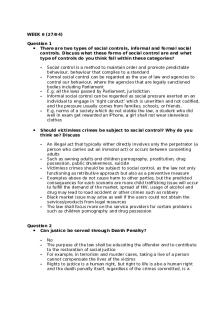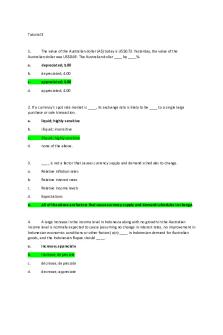Tutorial 3 PDF

| Title | Tutorial 3 |
|---|---|
| Author | Louis Williams |
| Course | International Finance |
| Institution | Queensland University of Technology |
| Pages | 4 |
| File Size | 90.3 KB |
| File Type | |
| Total Downloads | 73 |
| Total Views | 187 |
Summary
Tutorial 3 - week 3...
Description
Tutorial 3
1. The value of the Australian dollar (A$) today is US$0.73. Yesterday, the value of the Australian dollar was US$0.69. The Australian dollar ____ by ____%. a.
depreciated; 5.80
b.
depreciated; 4.00
c.
appreciated; 5.80
d.
appreciated; 4.00
2. If a currency's spot rate market is ____, its exchange rate is likely to be ____ to a single large purchase or sale transaction. a.
liquid; highly sensitive
b.
illiquid; insensitive
c.
illiquid; highly sensitive
d.
none of the above.
3.
____ is not a factor that causes currency supply and demand schedules to change.
a.
Relative inflation rates
b.
Relative interest rates
c.
Relative income levels
d.
Expectations
e.
All of the above are factors that cause currency supply and demand schedules to change.
4. A large increase in the income level in Indonesia along with no growth in the Australian income level is normally expected to cause (assuming no change in interest rates, no improvement in Indonesian economics conditions or other factors) a(n) ____ in Indonesian demand for Australian goods, and the Indonesian Rupee should ____. a.
increase; appreciate
b.
increase; depreciate
c.
decrease; depreciate
d.
decrease; appreciate
5. In general, when speculating on exchange rate movements, the speculator will borrow the currency that is expected to appreciate and invest in the country whose currency is expected to depreciate. a. True b. False
6. An increase in Australian interest rates relative to German interest rates would likely ____ the Australian demand for euros and ____ the supply of euros for sale. a.
reduce; increase
b.
increase; reduce
c.
reduce; reduce
d.
increase; increase
7. In the above scenario, in equilibrium assuming no change in all else, the euro would ____. a. appreciate against the Australian dollar. b. depreciate against the Australian dollar. c. result is ambiguous. d. remain constant against the Australian dollar.
8. Baylor Bank believes the New Zealand dollar will appreciate over the next five days from A$.48 to A$.50. The following annual interest rates apply:
Currency
Lending Rate
Australian Dollars New Zealand dollar (NZ$)
7.10% 6.80%
Borrowing Rate 7.50% 7.25%
Baylor Bank has the capacity to borrow either NZ$10 million or A$5 million. If Baylor Bank's forecast is correct, what will its Australian dollar profit be from speculation over the five-day period (assuming it does not use any of its existing consumer deposits to capitalize on its expectations)? a.
A$521,325.
b.
A$500,520.
c.
A$104,262.
d.
A$413,419.
e.
A$208,044.
9. The real interest rate adjusts the nominal interest rate for: a.
exchange rate movements.
b.
income growth.
c.
inflation.
d.
government controls.
e.
none of the above
10. If inflation in New Zealand suddenly increased while Australian inflation stayed the same, there would be: a. an inward shift in the demand schedule for NZ$ and an outward shift in the supply schedule for NZ$. b. an outward shift in the demand schedule for NZ$ and an inward shift in the supply schedule for NZ$. c. an outward shift in the demand schedule for NZ$ and an outward shift in the supply schedule for NZ$. d. an inward shift in the demand schedule for NZ$ and an inward shift in the supply schedule for NZ$.
11. In the above scenario, NZ$ ____. a. appreciated against the Australian dollar. b. depreciated against the Australian dollar. c. result is ambiguous. d. remain constant against the Australian dollar.
12. If Australia and Japan engage in substantial financial flows but little trade, ____ directly influences their exchange rate the most. If Australian and Switzerland engage in much trade but little financial flows, ____ directly influences their exchange rate the most. a.
interest rate differentials; interest rate differentials
b.
inflation and interest rate differentials; interest rate differentials
c.
income and interest rate differentials; inflation differentials
d.
interest rate differentials; inflation and income differentials
e.
inflation and income differentials; interest rate differentials
13. Assume the following information regarding Australia and European annualized interest rates:
Currency
Lending Rate
Borrowing Rate
Australian Dollar
(A$)
6.73% 7.20%
Euro
(€)
6.80% 7.28%
Trensor Bank can borrow either A$20 million or €20 million. The current spot rate of the euro is A$1.13. Furthermore, Trensor Bank expects the spot rate of the euro to be A$1.10 in 90 days. What is Trensor Bank's Australian dollar profit from speculating if the spot rate of the euro is indeed A$1.10 in 90 days? a.
A$579,845.
b.
A$583,800.
c.
A$588,200.
d.
A$584,245.
e.
A$980,245.
14. The markets that have a smaller amount of foreign exchange trading for speculatory purposes than for trade purposes will likely experience more volatility than those where trade flows play a larger role. a. True b. False
15. The value of euro was A$1.30 last week. During last week the euro depreciated by 5%. What is the value of euro today? a.
A$1.365
b.
A$1.235
c.
A$1.330
d.
A$1.30...
Similar Free PDFs

Tutorial 3
- 3 Pages

Tutorial 3
- 4 Pages

Tutorial 3
- 4 Pages

Tutorial 3
- 12 Pages

3 - tutorial
- 6 Pages

Tutorial 3
- 6 Pages

Tutorial 3
- 4 Pages

Tutorial 3 - Lecture notes 3
- 5 Pages

Tutorial 3 Answers
- 4 Pages

Tutorial 3 Solutions - EC202
- 4 Pages

Tutorial 3 Solution - investment
- 3 Pages

Tutorial 3 - ccc
- 1 Pages

Tutorial work - 1 - 3
- 31 Pages

Tutorial 3 - Answers
- 6 Pages

OD tutorial 3
- 5 Pages

DEL tutorial 3
- 2 Pages
Popular Institutions
- Tinajero National High School - Annex
- Politeknik Caltex Riau
- Yokohama City University
- SGT University
- University of Al-Qadisiyah
- Divine Word College of Vigan
- Techniek College Rotterdam
- Universidade de Santiago
- Universiti Teknologi MARA Cawangan Johor Kampus Pasir Gudang
- Poltekkes Kemenkes Yogyakarta
- Baguio City National High School
- Colegio san marcos
- preparatoria uno
- Centro de Bachillerato Tecnológico Industrial y de Servicios No. 107
- Dalian Maritime University
- Quang Trung Secondary School
- Colegio Tecnológico en Informática
- Corporación Regional de Educación Superior
- Grupo CEDVA
- Dar Al Uloom University
- Centro de Estudios Preuniversitarios de la Universidad Nacional de Ingeniería
- 上智大学
- Aakash International School, Nuna Majara
- San Felipe Neri Catholic School
- Kang Chiao International School - New Taipei City
- Misamis Occidental National High School
- Institución Educativa Escuela Normal Juan Ladrilleros
- Kolehiyo ng Pantukan
- Batanes State College
- Instituto Continental
- Sekolah Menengah Kejuruan Kesehatan Kaltara (Tarakan)
- Colegio de La Inmaculada Concepcion - Cebu